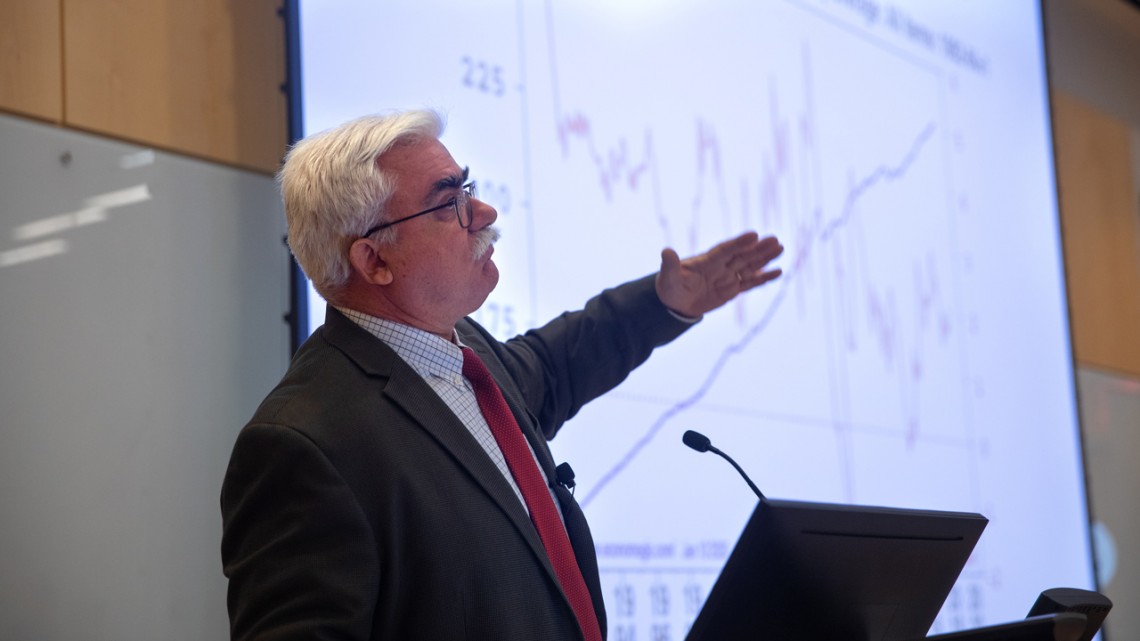
Steven Kyle gives his annual economic outlook at the 2020 Agricultural and Food Business Outlook Conference, Jan. 17 in Stocking Hall.
Downturn looms, but may not swing election
By James Dean
Could an economic slowdown sway the outcome of this year’s presidential election?
Don’t bet on it, said Steven Kyle, associate professor of applied economics and management. A nearly decadelong run of growth in the U.S. economy will peak in 2020, Kyle predicts, but a recession may not be evident until after the Nov. 3 election.
“We are softening a bit,” he said, “but there’s no sign of an immediate downturn in the next six months.”
Kyle offered his annual forecast for the national economy at the Charles H. Dyson School of Applied Economics and Management’s 2020 Agricultural and Food Business Outlook Conference, Jan. 17 in Stocking Hall.
The conference also featured presentations by Dyson professors on New York’s agriculture and food sectors and what climate change means for them, and detailed looks at the dairy, fruit and vegetable markets.
U.S. presidents, Kyle said, generally take too much credit and receive too much blame for ups and downs in the national economy. “Most of the time,” he said, “they’re just riding the wave as the rest of us do.”
But negative trends tend to prompt change in the Oval Office, as in 1980, 1992 and 2008, Kyle noted: “These things matter in the minds of voters.”
He cautioned that economic forecasts are more art than science, and no one can predict the business cycle.
Kyle gave himself a B-plus grade for last year’s outlook, which also anticipated a peak in the business cycle. He correctly forecasted gross domestic product growth, inflation and exchange rates in 2019, but didn’t believe unemployment and interest rates would remain so low.
Assessing the year ahead, Kyle reviewed a slate of economic indicators watched closely for signs of strength or weakness.
The Federal Reserve Board’s index of coincident activity, a snapshot of the current economy, shows a steady uphill climb since 2010. Its index of leading economic indicators, meanwhile, which aims to predict the coincident indicators six months out, is moving “sideways with a slight downward trend, but still in positive territory,” Kyle said.
That data suggest a recession – defined as two consecutive quarters of negative GDP growth – is coming, but won’t hit until this summer at the earliest, Kyle said, and possibly the fall, which means it wouldn’t appear in GDP data until well after the election.
Recent state-level indicators are fairly strong but show softness in potential swing states such as Ohio, Pennsylvania and Wisconsin, Kyle said.
Personal income – an important driver of consumption, which represents 70% of GDP – shows no sign of a slowdown. The story is the same for real manufacturing and trade industries sales, while industrial production appears to be moving sideways, Kyle said.
Additional positive signs he noted include historically low unemployment around 3.5%, low household debt and growing retail sales.
Consumer sentiment – described by the economist John Maynard Keynes as “animal spirits” – is an important factor in shifting business cycles, Kyle said. Do people wake up eager to invest, or worried about the future?
That sentiment is flat now, according to a University of Michigan index, but could sink in reaction to bad news about trade wars or an escalation of conflict with Iran, for example, Kyle said.
A red flag known as a “yield curve inversion” – when long-term interest rates are lower than short-term interest rates – was widely reported to have occurred last year. It’s a strong predictor of recession, but over a wide range of time, Kyle said.
In fiscal policy, Kyle considered that the Federal Reserve has little room to cut interest rates further, and that the economy has absorbed any stimulus from Trump’s tax cut. He expects Washington, D.C., to be consumed this year by impeachment proceedings and the election.
International trends are worrisome, he said, with China in recession and the European Union slowing down as the United Kingdom prepares to leave it. Several big unknowns that could hurt the economy include a potential constitutional crisis, further trade-war fallout or an actual war.
With all that in mind, Kyle offered “with more uncertainty than usual” his 2020 predictions:
- GDP will grow at a rate of 1.5%.
- Inflation will remain low, around 2%.
- Look for continued quarter-point interest rate cuts and paralyzed fiscal policy.
- Unemployment will rise slightly, to 3.7% or 4%.
“Leading indicators aren’t showing us that there’s going to be an immediate slowdown, but we are near a peak in the business cycle,” Kyle said. “I think we are going to have a peak [in the] next year. Whether it will be before the election or after, I have no clue at all.”
Media Contact
Get Cornell news delivered right to your inbox.
Subscribe
